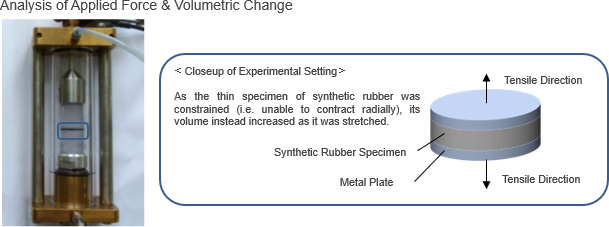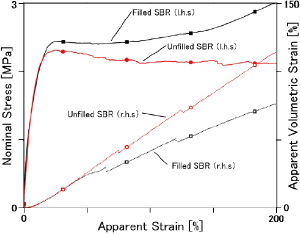Announcing the Results of Research into Rubber Failure with Potential to Improve Rubber Wear Resistance Performance
Jan. 09. 2019
Sumitomo Rubber Industries, Ltd. is pleased to announce the results of our joint research with the Leibniz Institute for Polymer Research (Dresden, Germany)* into the mechanisms behind rubber failure. This groundbreaking research has shed light on the heretofore unknown mechanism that causes microscopic voids within the rubber (i.e. the presumed origin of rubber failure) and leading to the formation and propagation of cracks. These findings open up new possibilities for the future development of rubber compounds that feature greater wear resistance than any type of rubber that has come before. Our company will continue working to translate the results of our cutting-edge research into high-performance tires that resist wear to maintain their performance for longer lifetime.
* Founded in 1948 as a textile research laboratory attached to a spinning mill, the Leibniz Institute for Polymer Research is now one of the largest polymer research facilities in Germany and is actively engaged in joint research with top research organizations from around the world.
With the automotive industry currently facing many sweeping changes, Sumitomo Rubber Industries has responded by formulating our SMART TYRE CONCEPT, a new tire technology development concept that aims to achieve "Even Greater Safety Performance" and "Even Greater Environmental Performance." The results of this recent joint research will contribute to one of the major development themes of SMART TYRE CONCEPT: "Performance Sustaining Technology" for tires.
While it has long been suspected that rubber failure (one of the major factors behind the phenomenon of tire wear) is due to the formation and growth of cracks in the rubber resulting from the fracturing of rubber molecules and the formation of voids within rubber at the microscopic scale, previous research had failed to fully explicate this theory. Thus, our company set out to observe the formation of voids in synthetic rubber. In 2015, we succeeded in shedding light on the formation of voids thanks to detailed molecular-level structural simulations that utilized our proprietary ADVANCED 4D NANO DESIGN as a new materials development technology, which has allowed us to establish new technologies to suppress void formation. With this latest joint research, we have now succeeded in directly observing internal structural changes in combination with the mechanical behavior of molecules within actual synthetic rubber specimens through two different types of experiments. The findings of this research will open up new possibilities for the development of rubber materials with extremely high durability by giving us greater control over viscoelastic properties of the rubber itself.
1. Using Computed Tomography (CT) to Analyze Changes in Force, Strain and Volume in a Thin Rubber Disk
■Experimental Methodology
A thin rubber disk specimen was placed between and affixed to two metal disk plates and stretched in a direction perpendicular to the contact surface (i.e. so that the plates were moving in opposing directions) in order to observe the relationship between applied stress and changes in volume as a function of apparent strain. At the same time, CT was utilized to directly observe the formation of voids within the rubber.

■Results
Due to the inherent properties of rubber, when a thin disk-shaped specimen is stretched in this way, its natural inclination is to contract radially (i.e. perpendicular to the direction of tensile stress). However, because the specimen was affixed to the metal plates, the rubber directly attached to the plates could not contract radially as long as it remained solidly affixed to the plates. As a result, the rubber was forced to expand, allowing us to directly observe the formation of voids through CT observation of the rubber interior.
From this experiment, we also learned that the circumstances of void formation can vary. In particular, we found that rubber failure in synthetic rubber containing filler material (such as silica or carbon black) occurred due to the formation of voids between agglomerates of filler material while rubber failure in synthetic rubber containing no filler material occurred due to the formation of voids resulting from the sliding of rubber molecules.
[Synthetic Rubber Tensile Stress - Strain (Deformation) Curve]
|
Studying the relationship between tensile stress, apparent strain and apparent volumetric strain in specimens of both filled and unfilled synthetic rubber, we found that apparent volumetric strain increased as apparent strain increased in both types of rubber. These results indicate that voids form within rubber due to constraint strain. |
 |
[Observation of Void Formation in Synthetic Rubber with Filler (Silica, Carbon Black)]
In filled synthetic rubber, voids formed between filler agglomerates and these voids then connected and combined to form cracks. The voids remain small due to the reinforcing effects of the filler material.
[CT Observation of Rubber Failure]

[Observation of Void Formation in Synthetic Rubber without Filler]
In unfilled synthetic rubber, voids will mainly be formed due to the sliding of rubber molecules. The initial voids then grow by merging of small voids due to crack propagation between these voids until the final formation of cracks.
[CT Observation of Rubber Failure]

2. Elucidation of Synthetic Rubber Failure Behavior through Analysis Using Small-Angle X-Ray Scattering (SAXS)
■ Experimental Methodology
A notched sheet specimen of synthetic rubber was stretched laterally (i.e. in the planar direction) while small-angle x-ray scattering was utilized to observe the formation and growth of voids within the rubber at the notch point.

■ Results
Using small-angle x-ray scattering to measure internal rubber density at the point of the notch in the sheet specimen of synthetic rubber, we found that the density of the rubber nearer to the notch was lower than the rubber in areas farther away from the notch, suggesting that many voids were forming within the rubber near the notch point. These results indicate that, when sheet rubber is stretched laterally (i.e. in the planar direction), voids exist at the point where the rubber tears. Thus, we have discovered that voids are directly involved in rubber failure, as had long been suspected.

We anticipate that the results of this research will lead to the development of rubber that is more resistant to failure and wear than any type of rubber that has come before. Sumitomo Rubber Industries will continue working to accelerate our efforts to establish our "Performance Sustaining Technology" for tire rubber toward fully realizing our SMART TYRE CONCEPT in the near future.

